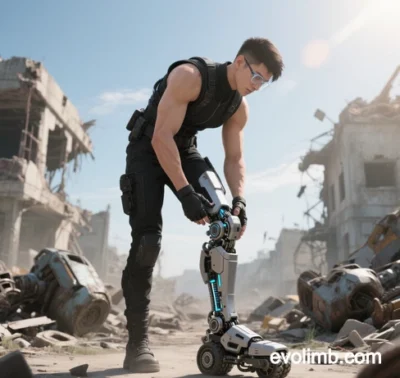
Evolimb: Adaptive Robotics and Bionic Limb Technologies Paving the Way for Human-Machine Symbiosis
The convergence of adaptive robotics (Evolimb) and bionic limb technologies is redefining the boundaries of human-machine symbiosis. By integrating neuro-mechanical closed-loop systems, dynamic environmental adaptability, and cognitive enhancement mechanisms, these advancements elevate human-machine collaboration to a seamless fusion. Below is an in-depth analysis of technological paradigms, applications, ethical challenges, and future trajectories.
I. Technological Paradigms: From Mechanical Replacement to Neural Integration
1. Evolution of Bionic Limb Technologies
- First-Generation Mechanical Prosthetics: Leveraged basic joint motion via mechanical linkages but lacked sensory feedback.
- Second-Generation Myoelectric Limbs: Used surface electromyography (sEMG) to detect motion intent but suffered from signal latency and noise.
- Third-Generation Adaptive Systems: Combine deep learning with tactile-proprioceptive feedback loops. For example, Hero Arm employs implanted electrode arrays for neural signal reading, achieving 50ms response times and 0.1N tactile resolution.
2. Core Technologies in Adaptive Robotics
- Human-Robot Impedance Matching: Variable stiffness actuators (VSA) mimic human joint viscoelasticity, enabling torque adjustment during heavy lifting.
- Multimodal Sensing Fusion: Integrates IMUs, pressure sensors, and optical deformation detection to model environmental dynamics. Cambridge’s bionic hand distinguishes textures like cotton and sandpaper.
- Online Learning Systems: Reinforcement learning frameworks allow users to train robots via physical guidance. Guillaume Gourmelen’s Wearable Robot Arm (WRA) learns tasks like coffee brewing in three demonstrations.
II. Applications: From Medical Rehabilitation to Human Augmentation
1. Medical Rehabilitation Breakthroughs
- Neural Injury Compensation: Paraplegic patients achieve autonomous walking via exoskeletons. Wu Xinyu’s lower-limb exoskeleton uses hybrid brain-computer interfaces (hBCI) with 95% gait recognition accuracy.
- Sensory Restoration: Retinal implants restore basic light perception in the blind. Bionic corneas now offer 20/200 visual acuity.
2. Industrial & Specialized Applications
- Worker Augmentation: BMW’s EksoVest exoskeletons reduce lumbar strain, boosting productivity by 40% over eight-hour shifts.
- Military Enhancements: DARPA’s Warrior Web exoskeletons enable soldiers to carry 180kg with terrain-adaptive jumping.
3. Human Capability Expansion
- Sensory Augmentation: ETH Zurich’s tactile-extended arm detects temperature gradients at 10 meters for hazard detection.
- Cognitive Synergy: Carnegie Mellon University’s metabolic algorithms optimize exoskeleton assistance, reducing long-distance running能耗 by 25%.
III. Ethical Challenges & Biosafety
1. Neuroplasticity’s Dual Impact
- Positive Adaptation: Long-term bionic limb users experience somatosensory cortex reorganization, repurposing brain regions for machine signals.
- Negative Risks: Prolonged brain-computer interface (BCI) use may accelerate neurodegeneration. Macaque studies show β-amyloid deposits after six months of invasive BCI use.
2. Philosophical Debates
- Identity Crises: MIT’s “Third Arm” experiments reveal 31% of users experience proprioceptive confusion, perceiving robotic limbs as biological.
- Equity Concerns: High costs (~$70,000 for advanced prosthetics) exacerbate healthcare disparities.
3. Technical Risks
- Autonomy Conflicts: AI-driven exoskeletons may override user intent for safety, as seen in a 2024 Munich climbing accident.
- Biocontamination: Self-healing bionic materials could release nanoparticles, risking ecological harm.
IV. Future Trajectories: From Tools to Symbionts
1. Technological Convergence
- Synthetic Biology: Embed CRISPR systems in bionic interfaces for on-site tissue repair (e.g., IL-10 anti-inflammatory release).
- Quantum Sensing: Diamond NV-center magnetometers enable single-molecule tactile resolution.
2. Societal Transformation
- New Professions: Construction workers may become “human-machine operators,” controlling multiple machines via neural interfaces.
- Longevity Revolution: Anti-aging bionic organs (e.g., artificial hearts) could extend average lifespans beyond 120 years.
3. Evolutionary Roadmap
- 2025–2030: Non-invasive BCIs reduce sEMG latency below 5ms.
- 2030–2040: Programmable biomaterials enable organ-level replacements (e.g., liver modules with alcohol metabolism).
- Post-2040: Hybrid intelligence emerges, blending distributed neural networks with quantum computing.
Conclusion
Evolimb aims not to replace humans but to forge a higher-order symbiotic civilization through bidirectional adaptation. This demands synchronized innovation in biodegradable interfaces (e.g., hydrogel coatings) and global ethical standards for neuroenhancement. When humans can control robotic limbs as intuitively as their own—while retaining veto power over AI interventions—the era of Evolutionary Symbiosis will truly begin.
Data sourced from public references. For collaboration or domain inquiries, contact: chuanchuan810@gmail.com





